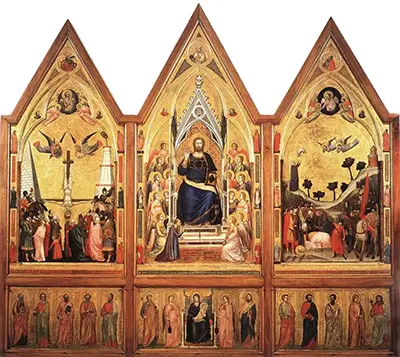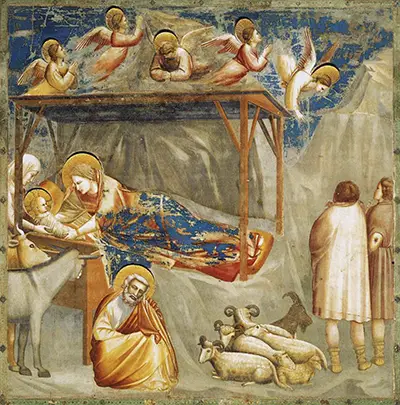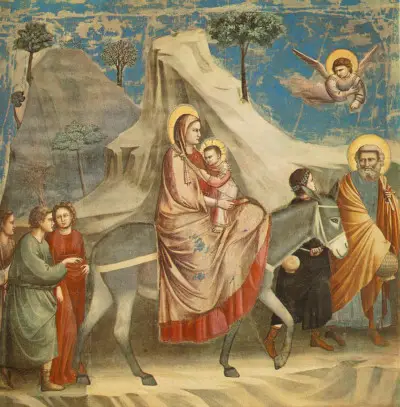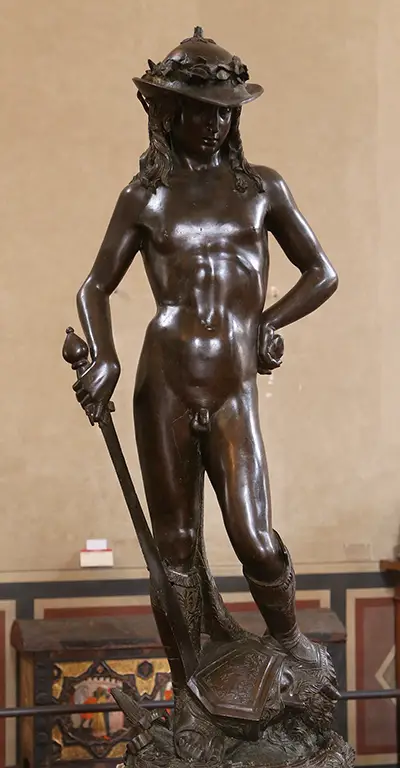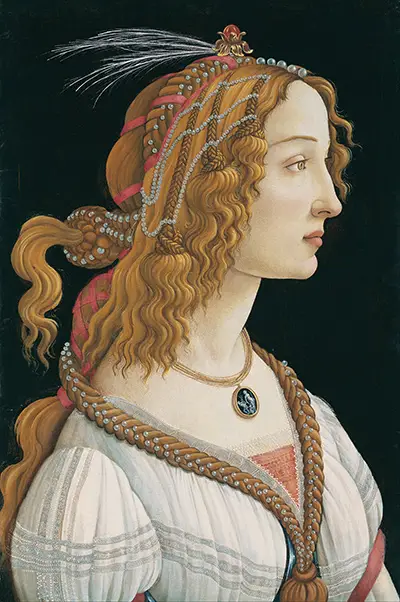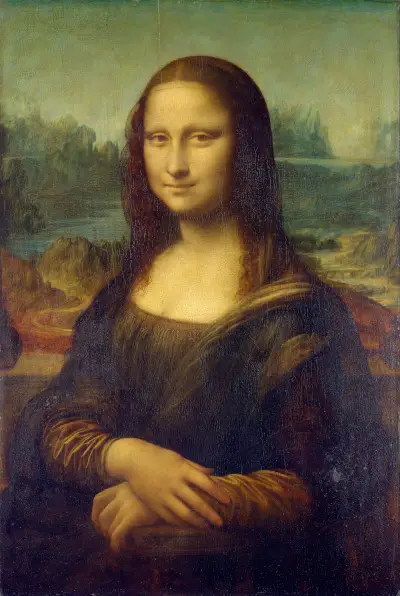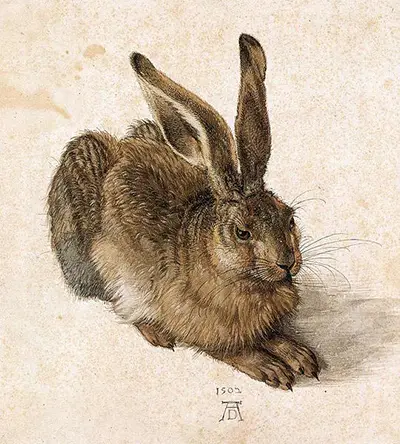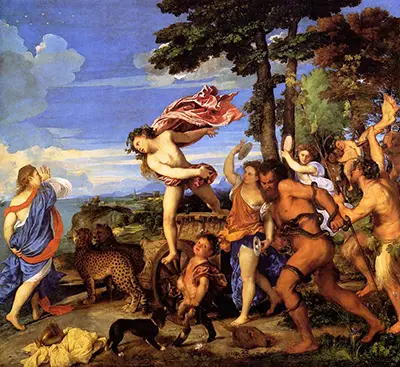Giotto di Bondone's huge depiction of the Last Judgement can be found in the Scrovegni Chapel in Padua and represents one of his finest frescos.
This colossal work (his largest contribution to the Scrovegni Chapel) dominates from its position in the west of the church, standing at an imposing 1000cm tall by 840cm wide. The size allowed Giotto to include huge numbers of supporting figures across the scene surrounding Christ who takes the focus in the centre of the composition. There are twelve apostles who stretch across the centre of the painting, with six either side of Christ. The remaining figures are then symbolically divided into sections above and below, left and right, depending on the whichever judgement has been delivered. Further detail provides greater contrast on heaven and hell. Additionally, it is the archangels of Michael and Raphael who can be seen holding the cross just below Christ himself. For the entire wall to be gifted to The Last Judgement, underlines the significance of this theme within Christianity, and this has led to many other artists also covering it within their own careers. It would appear more frequently within the Renaissance, both in northern and southern Europe, with some of those artworks then inspiring alternative versions in more recent times.
Such division of punishment and reward are common place throughout the Renaissance and offered religious followers a visual reminder of the importance of being a good citizen and a committed believer. Michelangelo's Last Judgement which sits in the Sistine Chapel remains the most famous depiction of this powerful theme. The related work of Sandro Botticelli who provided illustrations for Dante's Divine Comedy are also of supreme technical ability, just in a different medium. Giotto di Bondone sits alongside other famous names from around this time, such as Masaccio, Giovanni Bellini, Andrea Mantegna, Annibale Carracci and Gian Lorenzo Bernini in helping to shape the future styles of the Renaissance and moving art onwards from the medieval methods of earlier. Particular advancements were made in the use of perspective, which up to that point had been somewhat limited. Most are familiar with the flattened look of medieval art, but now these techniques would be replaced with more realistic, dynamic landscapes and scenes of architecture. One can track the manner in which common themes such as The Last Judgement have been handled differently across the ages, helping us to visually track the developments found from one movement to the next.
The Last Judgement (Giudizio Universale) is a theme that combines two worlds, the now and the what comes later. This provides a challenge to any artist tasked with merging these in a believable way that also remains faithful to the original Christian teachings. It is easy, however, to see why so many artists chose to take this item as inspiration for their own work, with it containing so much energy and passion. In many cases the artists would have been instructed as to a suitable theme by the donor, with little input themselves. Religious institutions held much of the wealth during the time of Giotto and so, inevitably, themes such as these would dominate the oeuvre of most major artists. They would re-visit many of these topics several times over, re-inventing them each time and tailoring them to the specifics of each requirement. You can see that for example here, where the upper section of the design is curved round, specifically to fit into the internal structure of the chapel. It is therefore pleasing that the item still remains within its original position, allowing us to see it just as the artist had originally intended.
Table of Contents
- What is the Meaning of the Last Judgement?
- Description of the Painting
- What Techniques were used for this Painting?
- What Artistic Style is used for The Last Judgement?
- Location of The Last Judgement within the Chapel
- When did Giotto decorate the Scrovegni Chapel?
- Did the Artist complete The Last Judgement by himself?
- What other Paintings did he add to the Chapel?
- What other Artists have covered this theme?
- Large Image of Giotto di Bondone's Last Judgement
What is the Meaning of the Last Judgement?
The Last Judgement is a famous religious concept in which judgement is passed over the people of every nation. Some are rewarded, and others penalised, depending on their behaviour across their lifetimes. It can also mark the second coming of Christ within Christianity and the contrasting nature of this theme has proven popular with artists across a variety of different art movements, and particularly so within the Renaissance. Islam would also incorporate the judgement into their own scripture and other off-shoots of the main religions have provided their own interpretations too. Art would tend to concentrate on scenes which could provide an immediate impact to the viewer, without the need for a fundamental understanding of the passage itself, and few items could offer such a simple but powerful message as that of the Last Judgement, which within Giotto's Italy is today known instead as Giudizio Universale. Such as with the spread of Christianity across Europe, so the theme would spread across art boundaries, with many memorable iterations to be found in Northern Europe, at a time when the region was competing strongly against Italian art with their own artistic innovations. Even with the reduction in the role of religion within European society today, its population is still entirely aware of the meaning of this theme.
Description of the Painting
There is much to see and admire within this artwork, but one's initial attention will likely be on the depiction of Christ, which sits centrally within a multi-coloured circular outline. A halo hovers around his head, signalling his divinity and his arms, symbolically, are spread apart. He sits upon a throne, delivering his judgement. The rest of the scene is then divided into three main sections, with those across the top looking downwards towards those being judged. At the bottom, we see those rewarded on the left, and those receiving punishment on the right. The content gives Giotto an opportunity to bring a heavy contrast of light and dark in this large mural and the overall piece features an extraordinary number of figures. The intensive row of angels at the top are positioned as a choir, whilst other notable figures just below them watch on as the events unfold. Christ is surrounded by a circle of angels as he appears from the heavens to deliver his judgement, with his iconic image appearing just below the chapel's window, which itself offers a view of the skies above Padua. Whilst the symbolism will inspire many who visit this stunning location, the aesthetic value is enough to interest many, even without an interest in the meaning behind this painting.
What Techniques were used for this Painting?
The artist would produce frescoes to cover the walls and ceiling of the chapel. The nature of this artistic technique means that work must be completed before the plaster dries, giving a window of a around one day at a time to finish each section. They would therefore focus on one part at a time, before moving on the following day. Dry powder pigment is used with water to add each design to the fresh plaster, meaning that each artwork was essentially installed into the building itself, rather than with oil paintings that can more easily be moved around. There are also alternative fresco techniques where paint is applied over dried plaster, but that was not how Giotto worked. Indeed, fresco itself is a term derived from the Italian word for fresh, hence the need to work quickly and plan a project out several days or weeks in advance. The method used here can be found across the world and actually dates back to Egypt many thousands of years ago, although it is now more closely linked to members of the Italian Renaissance, particularly in the minds of European art enthusiasts. Over time the use of oils and tempera would become popular alternatives which would slowly replace the mainstream use of fresco techniques.
What Artistic Style is used for The Last Judgement?
Giotto's style was somewhat more natural than the other major names around at the time. His figurative work was based on what he saw at the time, rather than an idealised version. Clothing and physical features would be faithful to what might imagine in real life, with much of that on display within The Last Judgement. He would use bright, uplifting colours and his approach seemed to be immediately accessible to the public. Leading up to his own career, art would often be with flat perspectives but Giotto helped to develop this artistic element, with later periods of the Renaissance taking that on yet further. Although The Last Judgement does not make much use of perspective, other works within the chapel certainly do. There would also be golden paint within many of his most famous paintings, but his work within the chapel focused on other colours, with blue tones being particularly prominent. Giotto came in the early period of the Renaissance, a served as a link between the medieval styles and the main period of the Renaissance itself, with many more famous names following in the next two centuries after his own career had come to an end.
Location of The Last Judgement within the Chapel
The Last Judgement covers the wall around the entrance to the chapel. The main series of frescoes then run along the two sides of the building, up to and including the ceiling itself. The significance of the theme itself within Christianity must have influenced Giotto's decision to pick this out specifically for the wall at the rear, rather than any of the other items that would be included within the chapel. There was also the opportunity within the judgement to include vast amounts of detail, as Giotto covered the reward and punishment delvered by Jesus, making it more suited to such a large composition. Finally, the contrast of good and evil, darkness and light, could additionally bring a large impact across that part of the chapel, rather than being confined to one of the many rows of artworks found across the longer walls. Giotto was not the only artist to pick The Last Judgement out for special treatment, with Michelangelo placing it across a single wall in the Sistine Chapel, alongside the altar, whilst other frescoes would also be arranged together in smaller formats. Indeed, many of the Renaisance artists would learn from each other and take on similar themes within their respective careers.
When did Giotto decorate the Scrovegni Chapel?
The land on which the chapel would later be built was purchased in the very early 14th century by Enrico Scrovegni. He had built up considerable wealth in the banking industry and wanted to create something for his family which made use of the finest art and architecture available in Padua at the time. Alongside a large mansion he would add the chapel, which would eventually be the burial spot for himself and his wife. Giotto's work would then be completed by 1305, thanks to the team of assistants who supported him over a period of nearly two years. The nature of fresco work meant that each day would be devoted to a specific artwork, which needed to be finished before the plaster of that section of the wall would dry. The artist would have been in his mid to late thirties at the time of this commission, meaning he was established as an artist but also physically able to work tirelessly to meet the agreed timeframe for the project.
Did the Artist complete The Last Judgement by himself?
Our knowledge is limited with regards specific frescoes within the chapel, but we do know that Giotto employed around 40 assistants to help out on this project. He would design and sketch out the individual frescoes, with skilled painters then delivering them one day a time. He would also have handled some of the significant details himself, and may well have taken on much of The Last Judgement himself, because of its significance within the overall project. If one studies the composition itself, it may well have been suitable for him to allow others to cover the less important sections, suc has the rows of angels in the choir at the top, whilst he would have given more attention to Christ on his throne. The frightening characters seen in the punishment section might also have required particular creativity and not be left to his assistants. Giotto would have played a role in selecting his assistants and working them around his own intentions, rather than having these workers thrust upon him. Without his acceptance of their help, the project would have run on much longer, which would have been unacceptable to the patron, Enrico Scrovegni.
What other Paintings did he add to the Chapel?
Lamentation and Kiss of Judas perhaps remain the two most famous artworks from Giotto's series in the Scrovegni Chapel, though The Last Judgement also holds a significant importance and prominence because of how it covers an entire wall. The overall series features episodes from The Life of Christ and Mary as well as the lesser known vices and virtues. Giotto would handpick themes from the original scripture which tended to related to key moments in their lives. It produced an impactful finish for visitors to the chapel, just as intended, and in the centuries that have passed since, many more thousands of tourists have enjoyed his achievement in person. This series of frescoes would also influence artists later in the Renaissance, in how these popular themes could be composed after he helped to push Italian art on from the medieval era into the exciting and dynamic approach found within the 14th to 16th century. Each of the individual frescoes can be treated as an independent artwork in its own right, whilst also serving as a single element of a wider series.
What other Artists have covered this theme?
The Last Judgement (Giudizio Universale) featured particularly frequently within the art world of the 14th to 16th century, mainly across Northern Europe and Italy. The theme would pass from one generation to the next, with each artist taking what had gone before and then adding in their own compositional and stylistic innovations. Even since then, there have been many more interpretations but we continue to refer most often to the work of the likes of Giotto. Aside from him is, of course, Michelangelo's altarpiece wall in the Sistine Chapel, which is perhaps the most famous version of them all. Elsewhere in Europe one can also find this woodcut engraving by Albrecht Durer, as well as this triptych by Hieronymus Bosch. These famous pieces would then inspire more recent work from the likes of William Blake, with the theme being used across a wide variety of mediums, way beyond just the fresco techniques of Giotto and his workshop from the very early 14th century. It is important to also remember that the content has passed into many other mainstream religious as well, leading to other styles being used for it right across the world though in the western world we continue to focus almost exclusively on its connection to the Christian faith.
Large Image of Giotto di Bondone's Last Judgement
This extraordinary artwork measures approximately ten metres in height, by 8.4 metres in width, matching the dimensions of the interior of the chapel wall. A large image is therefore necessary in order to see some of the fine detail added by Giotto and his assistants, which is provided below. This can help us to spot individual elements of the composition, with many dozens of figures included across the expanse of this design. There are also particularly interesting additions around the centre of the mural, with the enthroned Christ, as well as in the bottom right with some of the creatures that lurk in the darkness within the punishment section. The use of fresco techniques by Giotto has meant that some elements of these paintings have deteriorated considerably over the centuries that have passed since, perhaps not helped by the larger numbers of visitors which the chapel receives every year. Thankfully, local experts continue to protect and preserve the frescoes as best as possible, with the entire location also now considered one of the key cultural gems to be found in Italy.

More Renaissance Artists



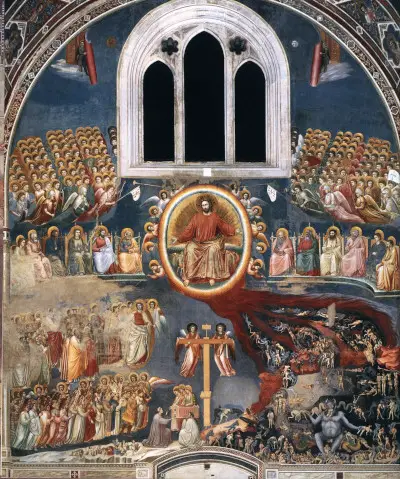
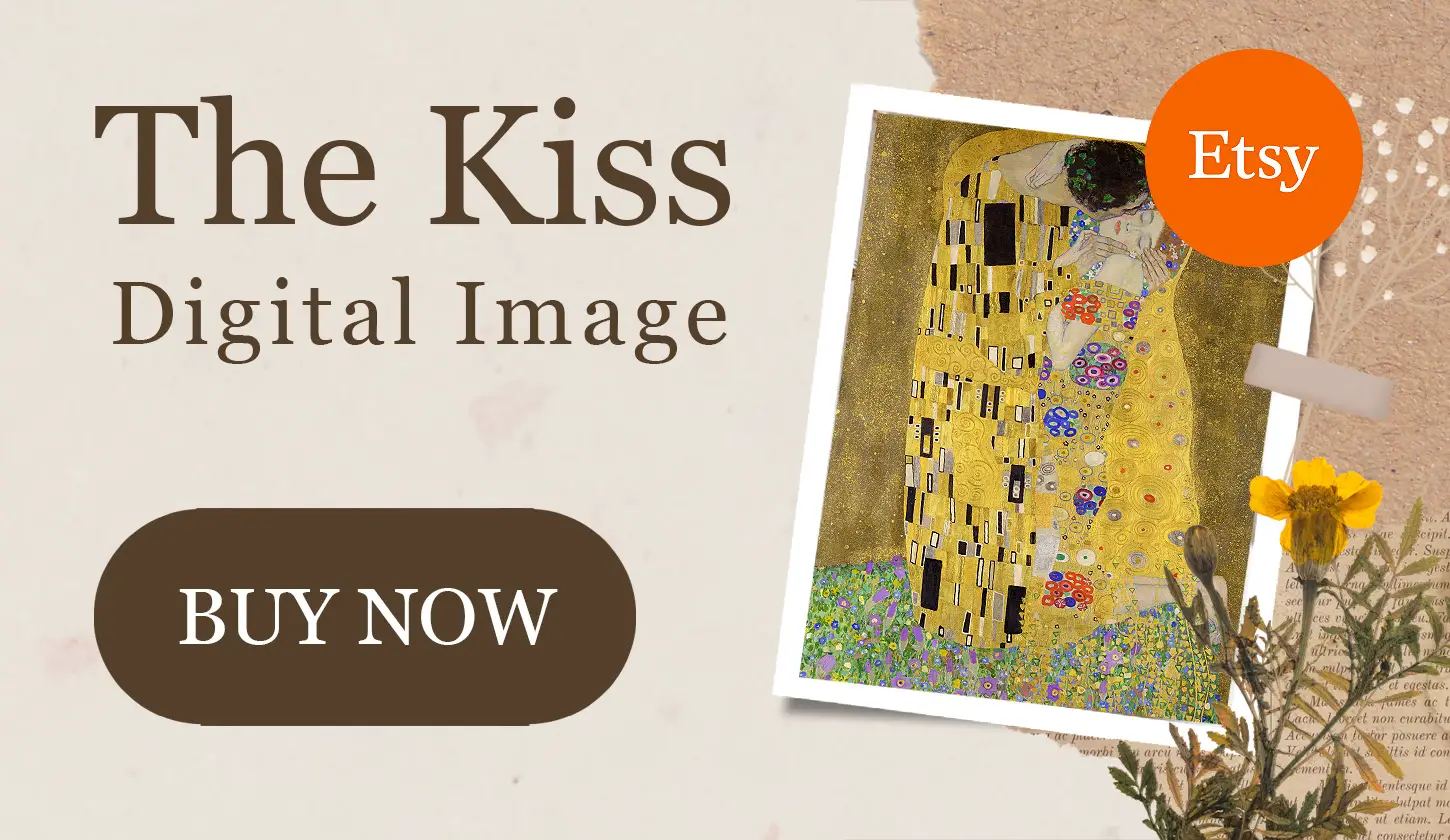
 Giotto.jpg)
 Giotto.jpg)
